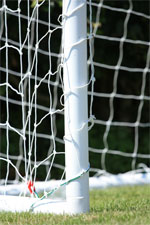
Over the last two decades, there has been a surprising amount of innovation both in the design and manufacture of goal posts that has drastically expanded the range available for the UK’s most popular sport.
From the material each goal is constructed from, to its size, shape and type, there’s now a bewildering array of football goals to choose between. In this buying guide, we’ll examine some of the key considerations when purchasing a new football goal.
Football Goal Sizes
| Age | Format | Pitch Size | Ball Size | Goal Size (ft) |
| U7’s & U8’s | 5v5 | 40×30 | 3 | 12×6 |
| U9’s | 7v7 | 60×40 | 3 | 12×6 |
| U10’s | 7v7 | 60×40 | 4 | 12×6 |
| U11’s & U12’s | 9v9 | 80×50 | 4 | 16×7 * |
| U13’s | 11v11 | 90×55 | 4 | 21×7 |
| U14’s | 11v11 | 90×55 | 4 | 21×7 |
| U15’s & U16’s | 11v11 | 100×60 | 5 | 24×8 |
| U17’s & U18’s | 11v11 | 110×70 | 5 | 24×8 |
The first (and most logical) starting point when choosing any type of football goal is the size required.
Players should use football goals appropriate to their height, as per the Football Association’s guidance (see table above).
As you can see, given the number of formats of the game, the wide range of goal sizes on offer becomes understandable.
Note: If you’re replacing a goal, particularly to fit existing sockets and have any doubt of its size – measure both the goal itself and the socket width.
Wooden, Plastic, Steel or Aluminium Goal Posts
Whilst the phrase ‘hitting the woodwork’ lives on in football commentary, football goals themselves haven’t been made from wood for some considerable time. We strongly recommend replacing any remaining wooden goals with steel or aluminium posts for safety reasons (crossbar snapping, splintering etc).
In fact, the FA’s goal post safety guidance states:
“There is no BS/CEN standard for wooden goals and it is unlikely that wooden goals will pass a load or stability test. The FA recommends that wooden goals should be replaced when necessary with compliant metal, aluminium or plastic goalposts. All wooden goals previously tested by independent consultants have failed strength and stability tests.”

Nowadays, aluminium goals have become the standard for many schools, academies and football clubs. The lighter weight of these goals makes them more manoeuvrable and since aluminium doesn’t rust, their lifespan will often far exceed that of a similar steel football goal. Aluminium goals are arguably more versatile than steel goals but are more expensive to manufacture, so will come at a premium.
Steel football goals are generally cheaper to manufacture but are much heavier than aluminium equivalents. Steel goals are particularly suitable for use in on recreation grounds, public places and when budgets are tighter. Anti-vandal options should also be considered if the goals are located in unsecured areas and likely to suffer abuse.
Plastic (uPVC) goals are also available from manufacturers such as Samba and Harrod Sport. Plastic goals are best suited for practice, social clubs, home or park use, but they’re portability/weight can also provide an inexpensive, temporary goal for use on synthetic pitches that won’t damage the surface. Samba do also manufacture ‘Match’ goals that are the regulation size for smaller sided games.
Socketed, Freestanding or Portable Goals
We generally refer to three types of football goal – these being socketed, freestanding and portable (or a “portagoal”).
As the name implies, socketed goals require posts to be placed into ground sockets – these should be set into cubes of concrete as per the manufacturers instructions (often 600mm³ or more). This installation should be performed by professionals to ensure the goal is safe to use. As socketed goals are already firmly in the ground, this type of goal requires no additional anchorage, making them a popular choice on recreation grounds and in other public areas.
Freestanding goals however do require anchorage either using ground pegs/chains/counterweights or weights that are integrated within the goal frame itself to ensure safe usage. Freestanding goals are particularly useful on synthetic pitches as they won’t damage the surface. However, keep in mind that unless a freestanding goal is fitted with wheels or a roller bar (so that it becomes a portable goal), it will require up to 4 people to safely it into position.

Self Weighted / Integrally Weighted Goals
Originally manufactured by Harrod Sport, “self weighted” or “integrally weighted” goals have gained enormously in popularity in recent years thanks to their inherently safe and often highly portable design. Self weighted goals incorporate counterweights within the goal frame itself or as a weighted backbar attached to the rear of the goal.
The importance of safely anchoring football goals at all times cannot be understated. Fatalities in the past have sadly occurred due to goal posts being anchored incorrectly, allowing the goal to tip. One of the main benefits of self weighted goals is they help eliminate some of this responsibility due to being counterbalanced by design at all times.
If fitted with wheels or a back roller bar, goals with integral weights are an attractive option for use on synthetic and grass pitches, shared pitches and for football clubs and schools that frequently move goals in and out of position.
Contact Us!
For more information on any of the goals available at sportsequip.co.uk, please contact us on 01858 545789.
